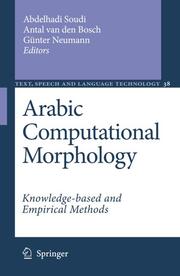Detailansicht
Arabic Computational Morphology
Knowledge-based and Empirical Methods, Text, Speech and Language Technology 38
ISBN/EAN: 9781402060458
Umbreit-Nr.: 1586310
Sprache:
Englisch
Umfang: viii, 308 S.
Format in cm:
Einband:
gebundenes Buch
Erschienen am 11.09.2007
Auflage: 1/2007
€ 160,49
(inklusive MwSt.)
Nachfragen
